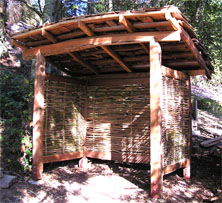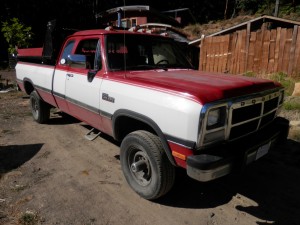Sustainability
What is reclaimed cedar?
In an effort to reduce our environmental impact and support sustainablity, Thuja Wood Art uses all salvaged, reclaimed, or recycled wood mostly from beach driftwood, and occasionally shake block forest licenses on the west coast of Vancouver Island.
Its all about the smell… I’d like you to close your eyes for a moment, and imagine we are on a remote west coast beach. The sun on our backs. Walking over driftwood and across the sand. You can smell the salt air on the breeze… this is where my part of the story begins.
But before me, the red cedar tree lived for hundreds of years in the forest, a cornerstone of northwest coast First Nations culture. Called the ‘Tree of Life’, it is still held in highest respect by northwest coast peoples for its healing and spiritual powers.
I salvage and reclaim only the best quality clear, tight grain old growth red cedar. And how can you tell which driftwood is cedar? Follow your nose. Red cedar has a wonderful and distinct smell, which always draws me in…and so the cedar begins a new journey on the path from driftwood to functional art. Reclaimed wood typically comes from old-growth timber that was harvested from trees bigger and older than anything currently being harvested today. As a result, this wood possesses superior characteristics to new-growth lumber.
 Working the cedar with wedges and a sledge hammer, first I must split it into manageable bolts, which I can transport back to my workshop. I use mostly hand tools to work the wood, with the froe and mallet doing the bulk of the work. Mortise and tenon traditional joinery allows the wood to hold itself together without the use of nails or screws. A copy of a Foreshore Wood Collection document the BC Ministry of Forests, Lands and Natural Resource Operations outlines our low-impact guidelines for salvaging timber from foreshore zones.
Working the cedar with wedges and a sledge hammer, first I must split it into manageable bolts, which I can transport back to my workshop. I use mostly hand tools to work the wood, with the froe and mallet doing the bulk of the work. Mortise and tenon traditional joinery allows the wood to hold itself together without the use of nails or screws. A copy of a Foreshore Wood Collection document the BC Ministry of Forests, Lands and Natural Resource Operations outlines our low-impact guidelines for salvaging timber from foreshore zones.
Thuja Plicata (species name for…) – Western Red Cedar
The official tree of British Columbia, red cedar is renowned for its natural beauty and outstanding physical properties. These properties make cedar a natural first choice for outdoor woodworking. Red cedar’s natural oils make it the most rot-resistant of woods.
Classified as a DURABLE WOOD by building codes across North. America, this permits its use for exterior applications without preservative treatments.
Cedar shrinks and swells minimally with changes in moisture giving it superior resistance to warping, cupping and twisting. Cedar has outstanding dimensional stability, which is greatly increased by splitting the wood instead of milling it (which doesn’t follow the grain). Handsplit cedar is many times stronger than milled wood of similar dimension.
 Finishes
Finishes
We use only environmentally safe stains when clients want to clear coat their artifacts to keep the beautiful orange/red tones of the cedar when it is first split and/or sanded. We use mostly oil finishes which penetrate deep into the wood, providing UV protection and helping keep the beautiful colours in the cedar. We can recommend finishes which carry an environmentally safe stamp. For finishing indoor pieces we like Landmark Natural Oil Finish (an all natural/foodsafe blend of Tung oil, Linseed oil, Pine Rosin, citrus, and beeswax). For indoor and outdoor finishing we use clear oil based products from the German company OSMO. They are environmentally safe, and have great products and service. No matter what you coat your wood with if it is in full sun, exposed to wind and rain, or near the ocean it will need recoating regularly to keep the colour.
Many clients choose to leave the cedar untouched, and it turns a wonderful silver colour in the first few years. Western Red Cedar, in it’s natural west coast environment, contains natural oils to protect it against deteriorating outdoors. It is the only wood allowed by building codes across north america to be used outside without any coatings. We always make sure to keep posts off the ground with the use of metal saddles set in concrete or rock. This ensures a long life with our projects.
Hinges & latches
 Thuja Wood Art designs custom metalwork for hinges and latches, and post saddles, which are made by local metalsmith’s, Jeri Sparshu from Thistle Rock Forge on Salt Spring Island, and Callum McKay Stainless By Design on Pender Island. We hand craft our hardware from forged steel, recreating the classic look of wrought iron hardware from the past, and using natural wax finishes on the metal while still hot as is tradionally done. We have designed our own latches, which are an easy to use sprung design with a variety of handle shape options. You will not find any better quality latches. (I know because I have tried, and the best solution was to design my own…) Contact us for more information on purchasing custom hinges or latches, pricing, and shipping.
Thuja Wood Art designs custom metalwork for hinges and latches, and post saddles, which are made by local metalsmith’s, Jeri Sparshu from Thistle Rock Forge on Salt Spring Island, and Callum McKay Stainless By Design on Pender Island. We hand craft our hardware from forged steel, recreating the classic look of wrought iron hardware from the past, and using natural wax finishes on the metal while still hot as is tradionally done. We have designed our own latches, which are an easy to use sprung design with a variety of handle shape options. You will not find any better quality latches. (I know because I have tried, and the best solution was to design my own…) Contact us for more information on purchasing custom hinges or latches, pricing, and shipping.
Bamboo
 Colin uses bamboo in a variety of projects. Bamboo is a very fast growing and sustainable plant to work with. It is very strong and adds an aesthetic, complimentary quality when used in conjunction with cedar. We hope to grow our own bamboo varieties in the near future.
Colin uses bamboo in a variety of projects. Bamboo is a very fast growing and sustainable plant to work with. It is very strong and adds an aesthetic, complimentary quality when used in conjunction with cedar. We hope to grow our own bamboo varieties in the near future.
Bio-fuels
 At Thuja Wood Art we are trying to reduce our use of fossil fuels by running our 1993 Dodge Cummins Turbo Diesel work truck on recycled waste vegetable oil from local restaurants, and also driving a hybrid electric family car.
At Thuja Wood Art we are trying to reduce our use of fossil fuels by running our 1993 Dodge Cummins Turbo Diesel work truck on recycled waste vegetable oil from local restaurants, and also driving a hybrid electric family car.

A Coast Salish Story
Local first nations say that the Great Spirit created Redcedar in honour of a man who was always helping others.
‘When he dies and where he is buried, a cedar tree will grow and be useful to the people – the roots for baskets, the bark for clothing, the wood for shelter’



